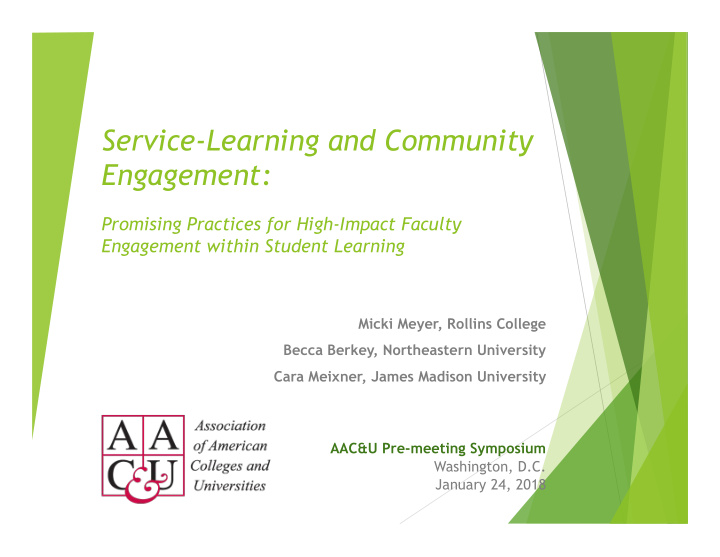



Service-Learning and Community Engagement: Promising Practices for High-Impact Faculty Engagement within Student Learning Micki Meyer, Rollins College Becca Berkey, Northeastern University Cara Meixner, James Madison University AAC&U Pre-meeting Symposium Washington, D.C. January 24, 2018
Disclosure and Recognition: Edited Volume (in-press), June 2018 Re-conceptualizing Faculty Development in Service-Learning/ Community Engagement Exploring Intersections, Frameworks, and Models of Practice We express deep gratitude to the many educational developers and S-LCE professionals, and their institutions, who contributed to this edited volume; please refer to the handout for a complete listing of chapter titles and contributors.
Session Outcomes: Participants will: 1. Identify research-informed themes from the intersection of faculty development and S-LCE; 2. Engage in dialogue around research-informed practices, models, and frameworks emerging from the themes; 3. Share promising practices and strategies for success. Identify research- Dialogue around Develop strategies to + = informed themes practices, models, advance S-LCE supporting faculty and frameworks faculty development
Who’s in the Room? ① A faculty member? ② An academic administrator? ③ A service-learning professional? ④ A faculty developer ⑤ All of the above ⑥ A mix of the above ⑦ None of the above
But first, what is S-LCE…..? A distinctive pedagogy, seminally described by Bringle and Hatcher (1995) as “a u course-based credit-bearing educational experience in which students: u (a) participate in organized service activity that meets identified community needs, and u (b) reflect to gain further understanding of course content, a broader appreciation of the discipline, and an enhanced sense of personal values and civic responsibility” (p. 112). A practice that “clearly ‘raises the pedagogical bar’” (Howard, 1998, p. 23), u though relatively little is known about the faculty experience of S-LCE.
… and who are S-LCE Professionals and Educational Developers? v May (or may not) be one in the same & often are also faculty; v Serve as “third space” professionals (Witchurch, 2013); v Inhabit the margins or interstices (Green & Little, 2012, 2013); v Act as arbiters of the 6 cultures of the academy (Bergquist & Pawlak, 2008); v Facilitate “faculty development and support” (Dostilio, 2017, p. 50).
… AAC&U Intersections
Interlude: 1. Think (on your own) u As you think about S-LCE on your campus, what are the successes? What are the tensions? 2. Pair (briefly, with someone at your table) 3. Share & Consider research-informed practices that mitigate tensions and highlight pride points (with the full community)
Pride and Dissonance: Recognizing the “messy” and complex S-LCE Context (Welch & Moore, Ch. 1) “S-LCE professionals need to account for a variety of push and pull factors , not only those directly related to faculty, but also to other stakeholders like students, administrators and community partners…” Welch and Moore (n.p., in press).
Pride and Dissonance: Navigating the institutional context (Stokamer, Ch. 9) “Community engagement in higher education necessitates mindful integration of the needs and interests of multiple stakeholders. By attending to an institution’s characteristics, priorities, and culture , S-LCE professionals are better positioned to orient their work toward what makes sense for their institutional context, which fosters the credibility essential to effective S-LCE programming. Ultimately, doing so has the potential to increase their achievement of desired outcomes.” Stokamer, n.p., in press.
Pride and Dissonance: Seeing faculty as co-learners in a complex, multivariate system (Eatman, Ch. 2) “One may argue that faculty development writ large is a critical aspect of strategic institution building in that it provides channels for faculty to be involved and contribute to the development of institutional vision, mission, values, and goals, beyond strengthening teaching, to policy, governance, strategic planning, and other aspects of institutional life. This is to say that the principle of agency lies at the core of faculty development.” Eatman (n.p., in press).
Pride and Dissonance: Considering reciprocity and partnerships (Barreneche, Meyer, & Gross, Ch. 10; Kiely & Sexsmith, Ch. 12) [Developers] are advised to assist faculty in understanding how to design an asset-based approach to building partnerships in S-LCE, such as learning how to develop a stakeholder map, assess relations of power, listen eloquently, embrace humility encourage voice, and develop relationships with community members based on trust, fairness, inclusion, voice, and mutual benefit of both service and learning. Kiely & Sexsmith To Kiely & Sexsmith (Ch. 12), key FLOs include the ability to: Describe diverse program and • community partnership models; Conduct site visits; • Design a plan for risk management;, • Explain the history and meaning of • community from multiple perspectives; and, Identify key elements to nurturing a • healthy and sustainable community- campus relationships (Jacoby, 2015). From Barreneche, Meyer, & Gross, Ch. 10
Pride and Dissonance: Contemplating special pedagogical considerations… like the large classroom experience (Variawa, Ch. 8) “My perspectives as an engineering Chirag Variawa engages his class of 800-1200 engineering instructor lend to my experience students in S-LCE each semester. designing a learning environment, in that I examine inputs and outputs inherent in designing a product, device, or process. This perspective affords a unique vantage point where we can understand how to systematically optimize a teaching and learning experience. Understanding the context, framing the challenges present, and using a combination of divergent and convergent strategies to solve these challenges are at the basis of engineering design thinking.” To do so, he marries universal design, engineering design, backward design, and team learning pedagogies with a reciprocal Variawa, n.p., in press. understanding of community needs.
Discussion: Campus Applications Navigating and reconciling situational factors (see handout) • What are the complexities, dynamics or obstacles that exist for faculty to engage in service-learning and community engagement? • What have been the moments of surprise liberation, i.e.: unanticipated favorable outcomes at your institution to advance the work?
Tying it all together: A theory of change
Recommend
More recommend